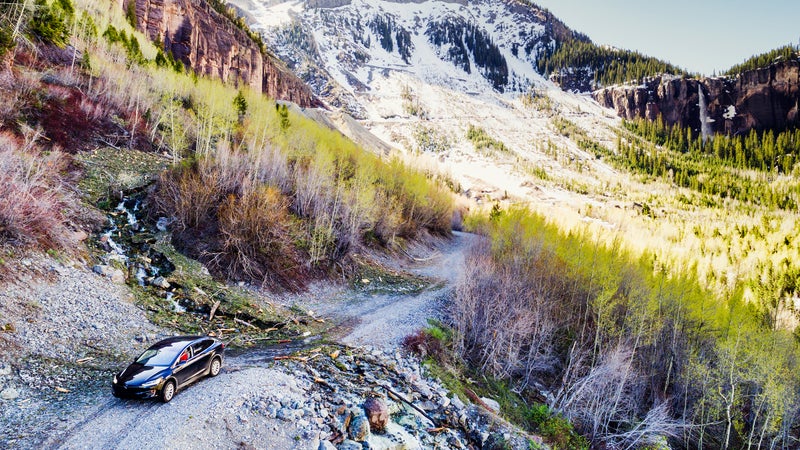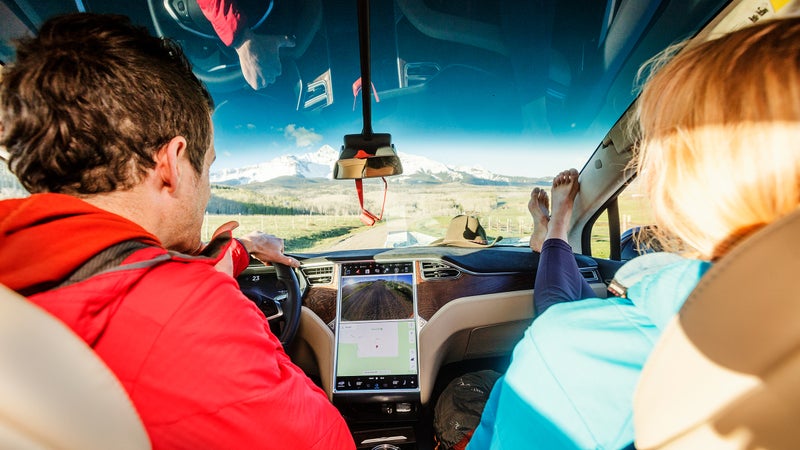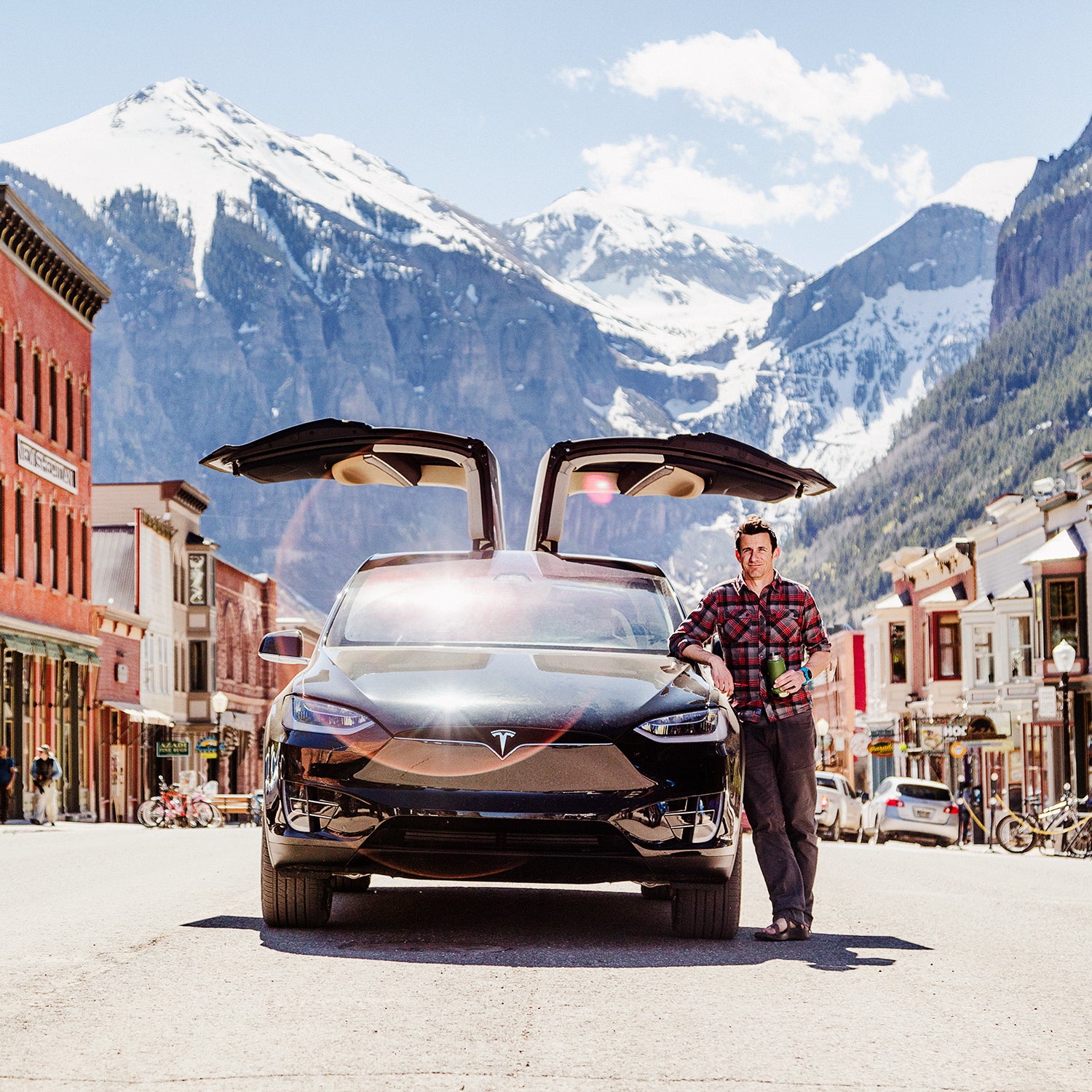As I unplugged the cord from my on a sunny afternoon in May, I struck up a conversation about electric cars with a gentleman in his sixties who was charging a Porsche hybrid next to me. We were parked at one of the most picturesque vehicle-charging stations in America, under thousand-foot-high red sandstone cliffs at a lot inside UtahÔÇÖs Zion National Park.
ÔÇťYou wonÔÇÖt get much charge for that here,ÔÇŁ he said, nodding at my car. The station delivered a meager 16 miles of battery life per hourÔÇöfine for a gas hybrid but not for us. I laughed in agreement and explained that I just needed to make it to my next station, 109 miles up the interstate. Such is the reality for electric-vehicle owners who want more than just a daily commuter.
After we juiced the car, my girlfriend, Hilary, and I loaded our camping and climbing gear into the TeslaÔÇÖs front and rear trunks, bade our neighbor goodbye, and pulled awayÔÇöreveling in that stealth electric-car silence. We had set out from our Denver home five days earlier on a six-day road trip in TeslaÔÇÖs new Model X 100D, the automakerÔÇÖs bid to reach a more adventurous demographic. ItÔÇÖs a black pod with all-wheel drive, a panoramic windshield, touchscreens everywhere, and TeslaÔÇÖs Falcon Wing doors, which open upward like on the famous 1980s DeLorean from .
ÔÇťWeÔÇÖre taking a dirtbag road trip in the least dirtbag car of all time,ÔÇŁ Hilary remarked. It kind of made me feel like a new brand of western pioneer. With 14 fully electric models made by BMW, Chevy, Ford, Nissan, and others delivering better range every year, we may soon see lithium-ion-powered adventure vehicles replace the iconic Volkswagen bus along classic stretches of American highway. So we sought to answer a simple but pertinent question: Can an electric car carry us on a road trip across the West?

Tesla thinks so. In fact, the companyÔÇÖs aggressive installation of charging stations on interstates around the country represents perhaps the single largest investment in that idea yet. So far, the company has built in the U.S., including 142 out west, with 141 more slated to open before the end of the year. At a Supercharger, it takes roughly an hour and a half to refill the Model X from zero to 100 percent, but it takes much longer at TeslaÔÇÖs more plentiful but lower-amp Destination Chargers, which are installed at hotels and restaurants. (With a special adapter, you can plug into the 675 or so non-Tesla stations in the region, often located at RV parks, but the charge flows slowly, so thatÔÇÖs a last-ditch option.) ÔÇťRoad trips are absolutely central to our vision,ÔÇŁ a Tesla spokesperson explained. ÔÇťOur plan is to cover all major forms of terrestrial transport, including long-distance travel.ÔÇŁ
Depending on an EV means recalibrating your relationship with the road. A fully charged Model X is designed to go 295 miles, but for now there is only about one Tesla station per 80 miles of interstate in the 11 Western states, so careful planning is essential, especially if you want to wander far afield. Driving a or a EV on the open road could prove even more challenging, since they have shorter ranges than the Model X.
“We're taking a dirtbag road trip in the least dirtbag car of all time,” my girlfriend remarked. It kind of made me feel like a new brand of western pioneer.
Even by conservative estimates, itÔÇÖs tough to fully account for the kinds of variables that can drain your battery. For instance, driving over I-70ÔÇÖs Loveland Pass en route to Arapahoe Basin on our first dayÔÇöa nearly 6,000-foot climb over 65 milesÔÇödepleted our battery by a third. Shortly after leaving A-Basin, we pulled off in Silverthorne to plug into a Supercharger. From a Chipotle across the street, I watched the charging progress on TeslaÔÇÖs app on my phone.
There were many of these long layovers during our trip. (Headwinds can also sap battery life.) Between Denver and Telluride, we stopped at two SuperchargersÔÇöa total of two hours on the cordÔÇökilling time at chain restaurants.┬á
These high-power stations arenÔÇÖt yet located in some of the WestÔÇÖs most desirable destinations. In Telluride, a town more than 126 miles from any Supercharger, our vehicle needed six hours at a Destination Charger just to make it to Moab, less than three hours away. Granted, we werenÔÇÖt sitting on the curb watching the seconds tick by; we traversed the via ferrata above town. Usually while our car charged we were climbing, skiing, or hiking. Which is the kind of stuff we were after in the first place. And once we set off exploring, the Tesla was plenty sporty: in a moment of adventurous driving on a rocky road, I tapped a touchscreen to raise the clearance to 8.3 inches and cruised along without worrying that weÔÇÖd bottom out.

But traveling charge to charge also got me wondering: What┬áhappens as more drivers buy EVs? The Superchargers we used had four or six vehicle slots, and no station was ever full. If there were more Teslas roaming around, however, I can imagine a not-too-distant future of long, 1970s-gas-crisis lines at Superchargers. TeslaÔÇÖs press contacts informed me that the companyÔÇÖs long-term goal is for cars to move themselves when theyÔÇÖre done charging. (For now, Tesla owners who leave their vehicles at crowded Super┬şcharger stations after the vehicle has been replenished are billed 40 cents a minute.)
If youÔÇÖre wondering whether you can pull off a road trip in an EV, the question you┬áshould be asking yourself is, How much time do I have? The tectonic shift from internal combustion engines to lithium-ion-powered electric motors is still in its infancy. Until┬áautomakers put more fast-charging stations on the roads and boost the driving range, weÔÇÖll continue to trade steady pro┬şgress for greener travel. In the meantime, EV road-trippers will have to adopt a little bit of what VW-bus drivers have always exhibited out on the open road: patience.


